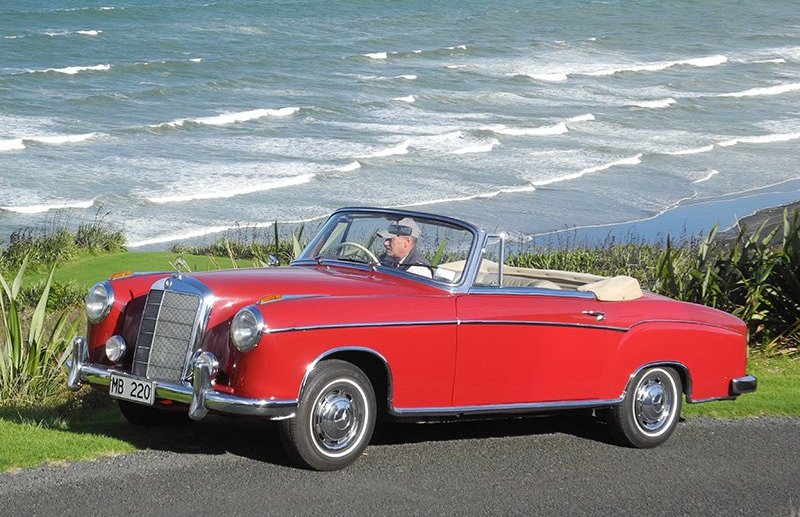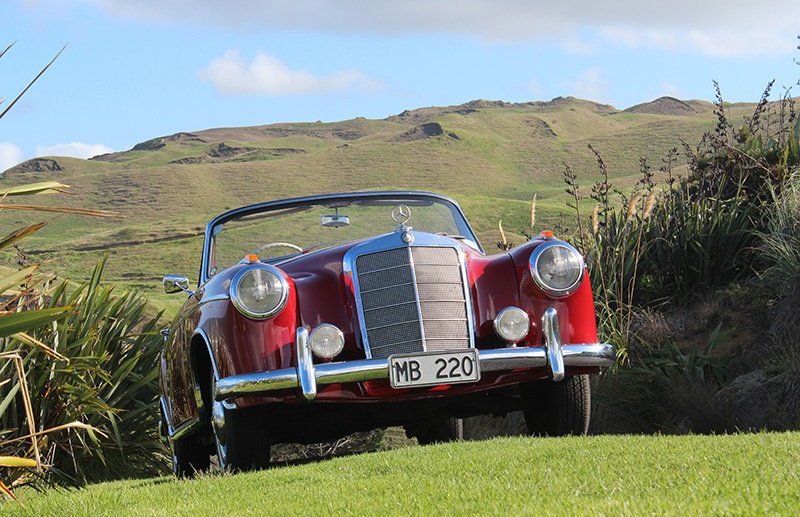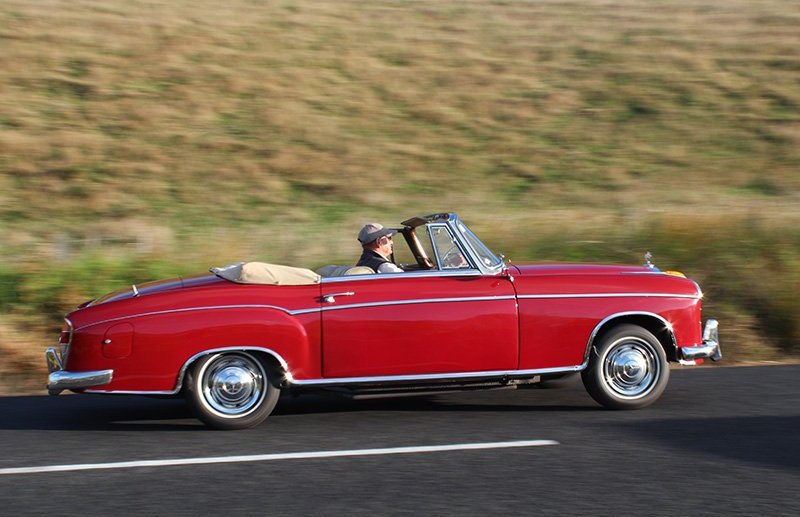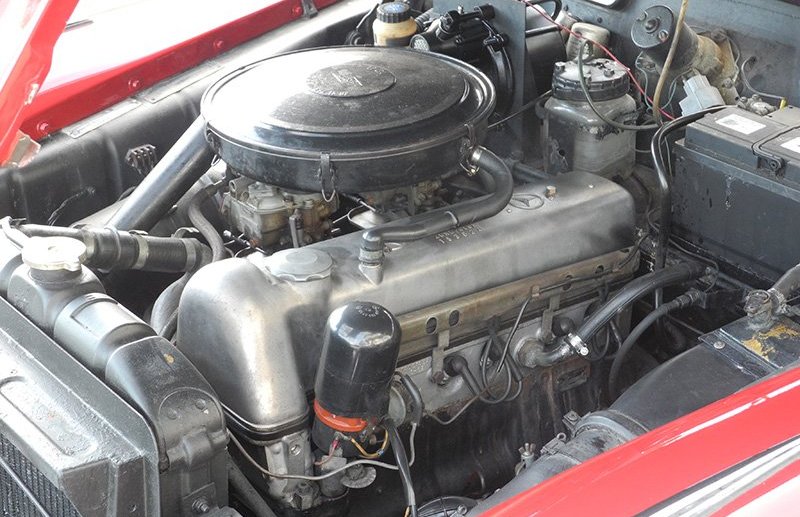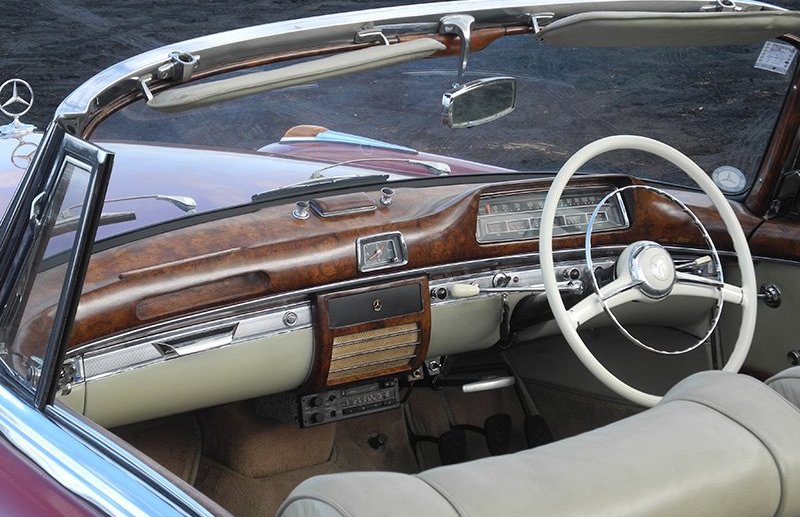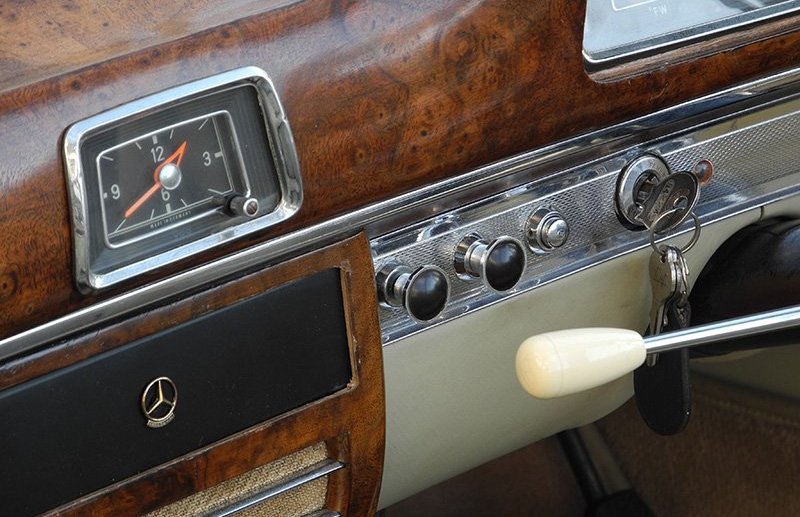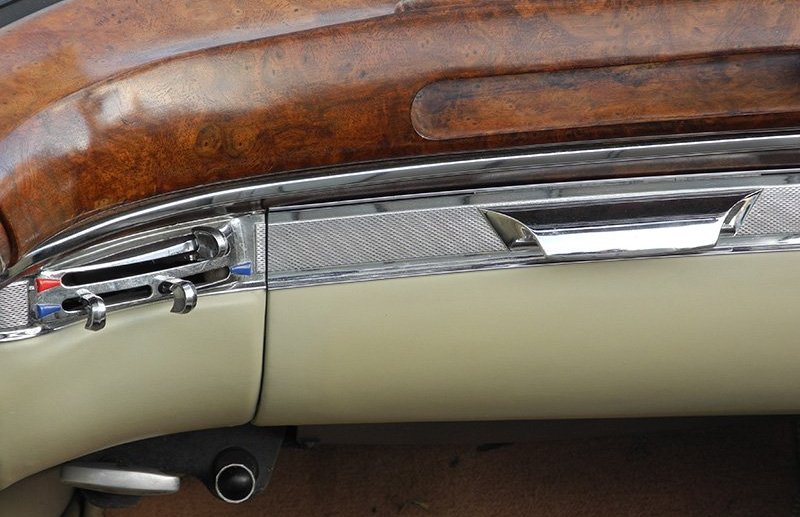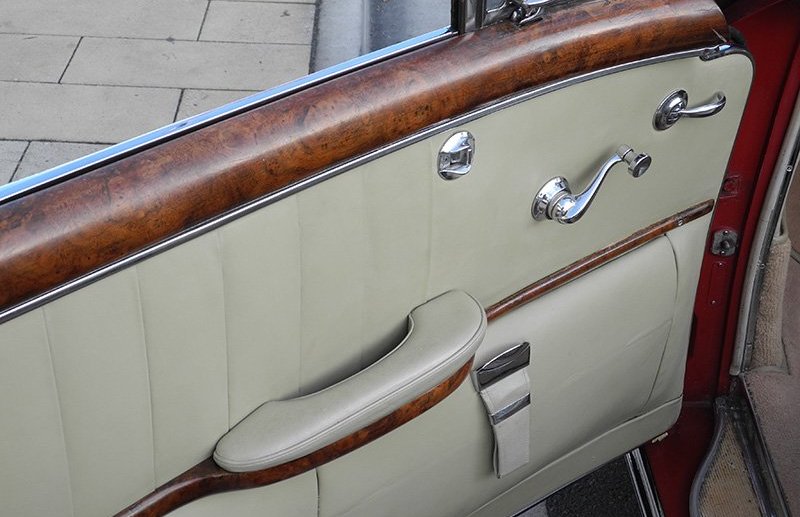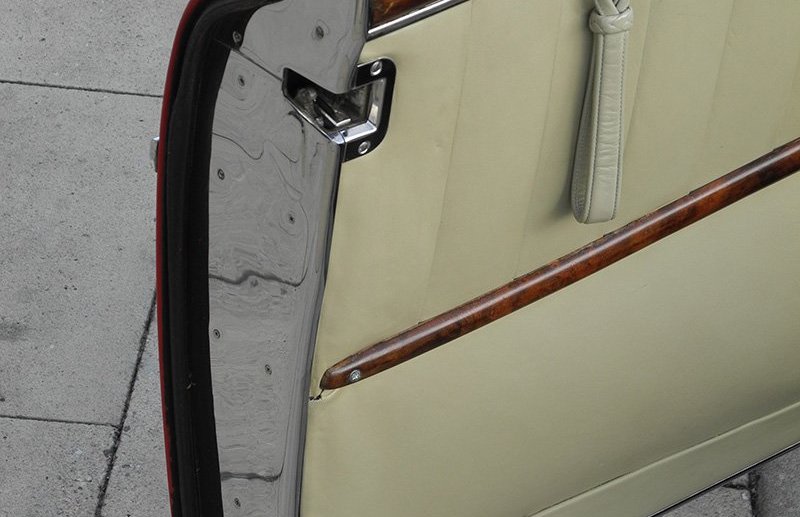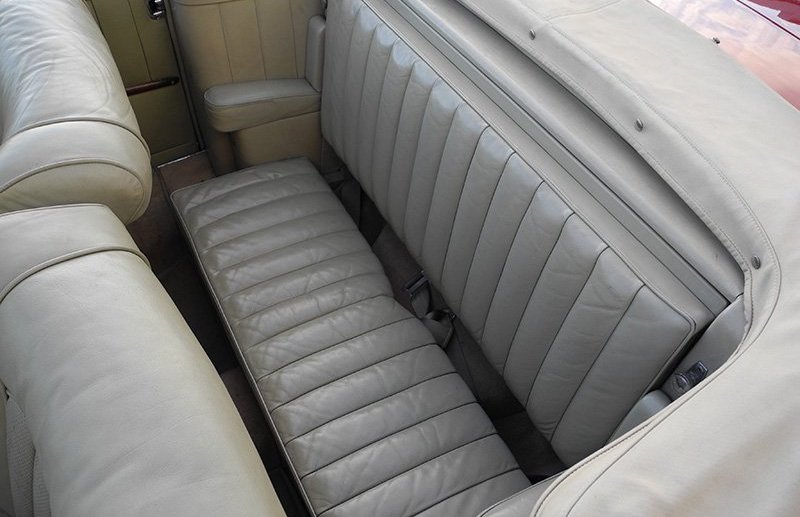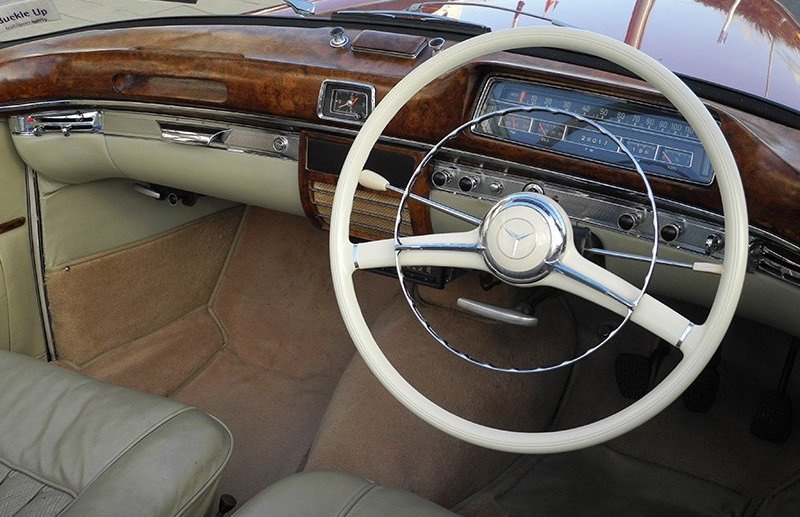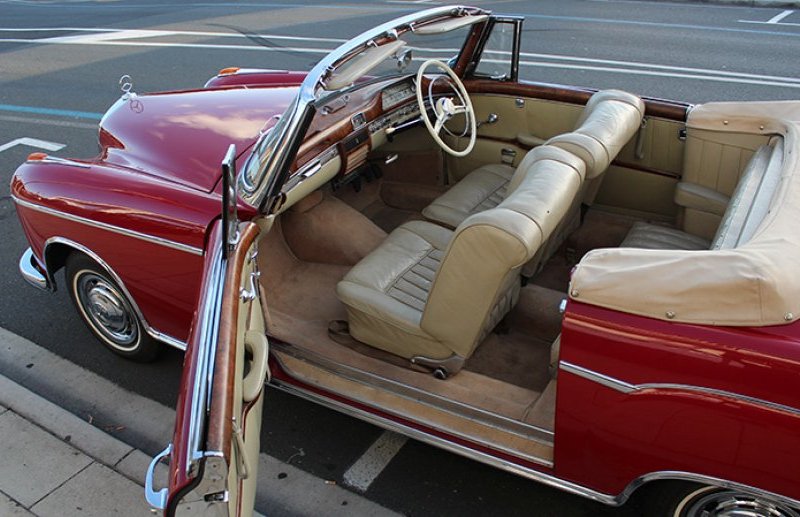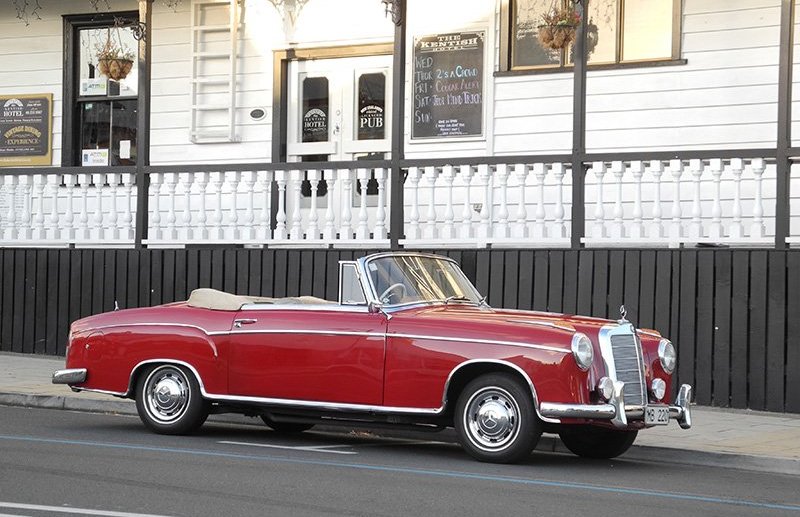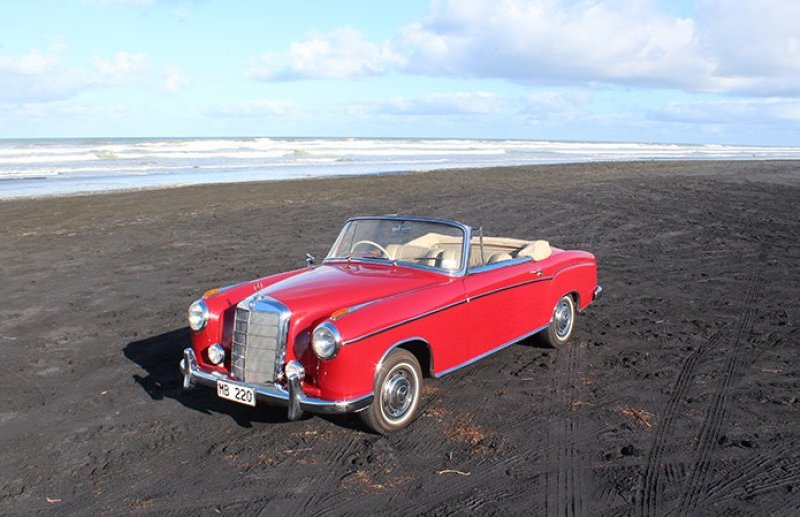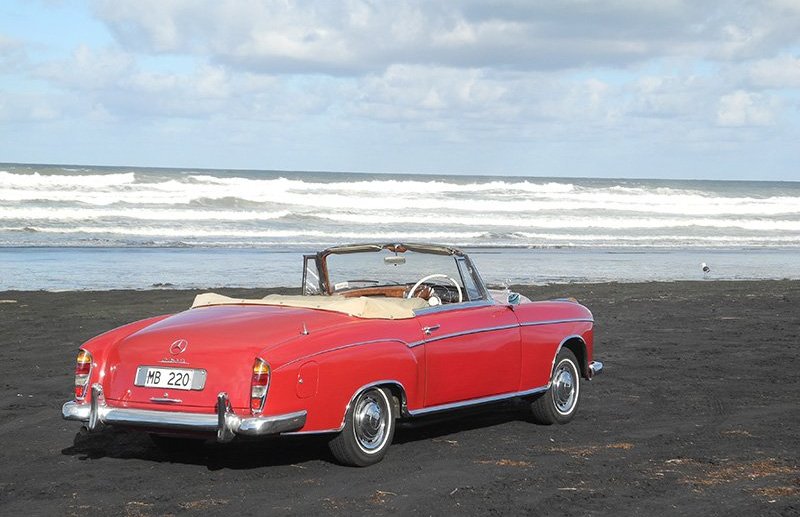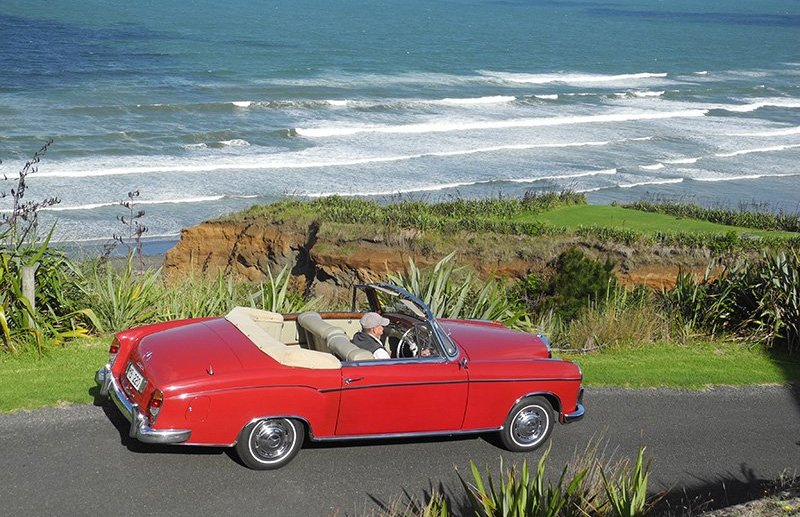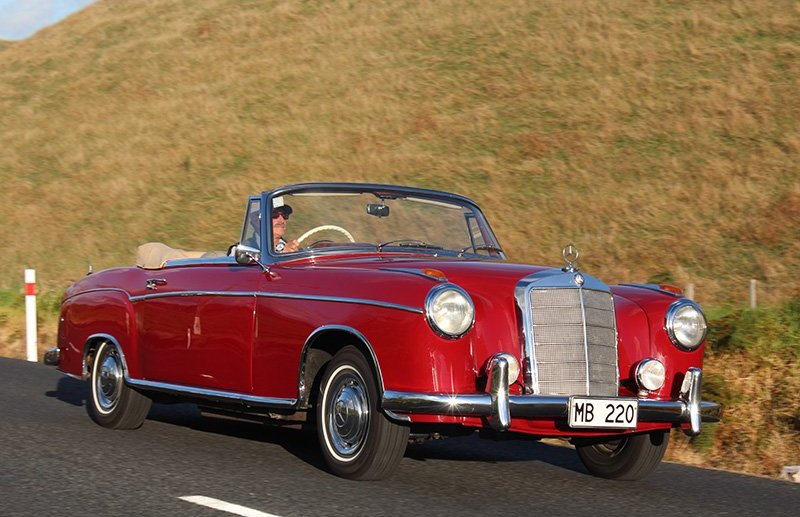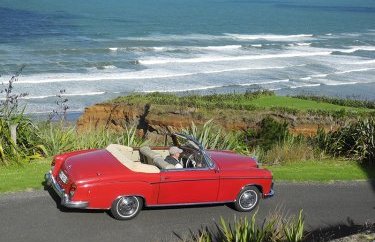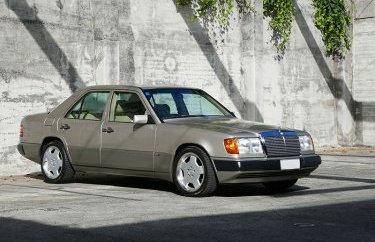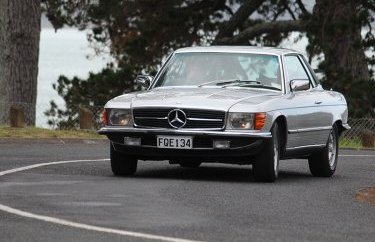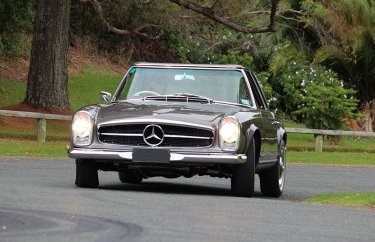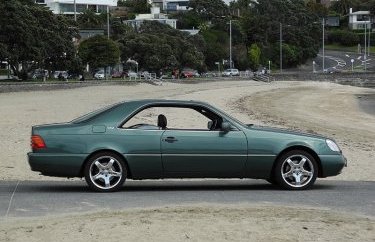1958 MERCEDES 220S CABRIOLET
Since arriving in NZ in the late 1980s, Ken’s rare cabrio has been a celebrated sight on the classic Merc landscape.
Car production is very much a numbers game, and precise figures can be frustratingly elusive for models built many decades ago. For example, there’s been plenty of conjecture over 220S Cabriolet production in the 1950s. We do know that of all six-cylinder Pontons produced, just three per cent were the cabriolets and two per cent coupes. And it seems likely that Mercedes built 2,178 220S Cabriolets between 1956 and 1959, predominantly for the US market, yet no more than 20 – and quite possibly fewer – right-hand drive models were ever built.
All of those right-hookers may have gone to wealthy British customers, as this car did in 1958. It subsequently underwent a quality partial restoration in the UK before being shipped to New Zealand in the late 1980s.
The 220S saloon made its debut at the 1955 Frankfurt motor show, where it was parked beside its Ponton stablemates, the 219 and 190 saloons. A year later the 220S Cabriolet version effectively replaced the 300S Cabriolet – a terrifically complex car by comparison and an extremely costly restoration proposition 60 years on. The new droptop was still ferociously expensive to buy due to the quality of engineering and materials, not to mention an exquisite level of detailing that it had inherited from the big 300 models.
Both the 219 and 220S were powered by 2,195cc straight-sixes, but only the 220S had twin Solex carburettors, raising peak power from 84bhp to 99bhp. In the eyes of chief development engineer Rudolf Uhlenhaut, the development of this SOHC engine was the most significant factor in Mercedes’ post-war recovery. The 220S Coupe arrived late in 1956 and, like the convertible, featured a shortened chassis and a wheelbase that was five inches shorter than the saloon’s.
The six-cylinder Pontons spoke of understated affluence. They required a longer bonnet to accommodate the bigger engine, giving them a more graceful snout. They also sported extra chrome, and foglamps and indicators mounted atop the front bumpers. The elegant two-door cabriolet certainly exudes class with its majestic grille, rounded bumpers and gently sculpted flanks, subtly enhanced by a thin chrome side strip and chrome wheelarch finishers.
The 1980s revamp of this 220S did not amount to a history-erasing restoration and much of the car remains original, a replacement hood and fresh hub caps being notable exceptions. Inside, the spacious cabin is simple in its layout and beautifully appointed with cream leather upholstery, a sensuously curved wood veneer dashboard and a thin rimmed, ivory steering wheel with delicate horn ring. Topped with a strip speedometer, the instrument cluster features four smaller, oblong gauges. The seats are firmly padded and offer front and rear occupants a high seating position. From the broad front chairs, there’s a commanding view over the curved, falling bonnet line, while wide doors offer good access to the generous rear bench, making this an occasional, fair weather five-seater.
Despite their modest capacity, the in-line sixes impressed as eager and robust units. From August 1957, the 220S motor’s compression ratio was increased from 7.6 to 8.7:1, lifting power to 105bhp, and this 1958 car benefits from that modest hike. With the sun setting on the Ponton’s production life, a number of cars (badged 220SE) further benefited from fuel injection.
All 220S Cabriolets were manual with a ‘four on the tree’ column mounted shift. The four-speed ’box is light and easy to navigate, and the recirculating ball steering – heavy by today’s standards – is generally positive and requires four turns lock-to-lock. A heavy hoof is required to work the brakes, which would benefit from the Girling disc brakes applied to subsequent models. Despite being servo assisted, they demand a decent shove, not that this is a frequent requirement when cruising down boulevards and collecting admiring glances.
The 220 Cabriolets were all about grace and space rather than outright pace but, for the thoughtful driver, they can be as much of a pleasure to drive as to behold, with roll-free progress through corners and good stability and road holding. At the back, the well developed, low-pivot-point swing-axle – common to all models in the range – provides independent movement and a level ride with good stability and adhesion. You could storm any road with confidence in favourable conditions.
Passionate owner Ken Williams has a long and positive history with Pontons, which explains his affinity with this car. “My first Mercedes-Benz was a 190 Ponton. At the time I was a young family man in need of a family car and, instead of buying a new Cortina, I bought a 10-year old 190 and just loved it. It had done a high mileage and I just took it up even higher. If it ever played up – and it rarely did – it was disassembled, you went and bought parts for it, and everything did what it was supposed to. They were built to last.
“What I like about the cabriolet is that it’s much the same as the old saloons, and spare parts are easy to come by. There are a few of them in paddocks rusting away with good mechanicals just sitting there, and if you want a spare motor or a gearbox, they are around.”
Ken has known of this 220S for more than 25 years, after first spotting it for sale in a newspaper classified. The car was purchased by local motor industry mogul, Sir Colin Giltrap, but soon changed hands again, bought by a collector Ken came to know well through club events. And as so often happens, after years of gently chipping away, Ken finally struck a deal a few years ago to buy both the 220S and a companion 230SL Pagoda.
“When I got the 220,” Ken recalls, “the brake booster had blown and been bypassed because it was a ‘hard fix’. That was the first thing I did – I pulled it out, got it overhauled, popped it back in and restored proper brake pressure.” The double layered hood may have been replaced 30 years ago but the coating was peeling off messily when Ken took over ownership. “I’ve recently recoated the hood and repainted it an off-white. You can get the hood up in a couple of minutes if it starts raining, but fixing the canvas cover over the folded hood can take more time.” Clearly, Mercedes cabrios have come a long way...
There isn’t much left on the car’s ‘to do’ list, however. “I’ve got some new rubbers for the front parking lights after sourcing brand new ones that are pretty hard to get. And I’m sometimes tempted to put disc brakes on the front; it’s not purist, but the later model discs bolt straight on. It’s very tempting because I’m not quite sure that the car’s going to pull up straight, especially after it’s been sitting around a lot.” When it does get out for a proper run, Ken ensures that the 220S doesn’t hang around. He bowled down the motorway in the fast lane this morning with hood down and headlights ablaze to get to our remote photo location by breakfast.
Our meeting point is the Kentish Hotel in the small township of Waiuku. Built in 1851 by Edward Constable (formerly of Kent, England), the Kentish was once the hub of trade and social life in the town and holds New Zealand’s oldest continuous licence to sell alcohol. Trade required ease of shipping and Waiuku is conveniently perched at the sheltered, southernmost tip of the expansive Manukau Harbour. Head due west though, and you end up on the rugged west coast where the Tasman Sea rolls in vehemently over black sand beaches equally suitable for exercising horses and vehicles.
Almost six decades after the Mercedes-Benz was delivered to its first English keeper, the car feels remarkably solid and surprisingly free of scuttle shake. Performance is quite lively, with decent acceleration to 60mph and a steady climb thereafter. “It will do 100mph if you want it to,” confirms Ken. “It’s a bit low geared and it’s revving a bit high for motorway cruising, with the tyre size probably a bit smaller than the originals. But there’s very little scuttle shake, the gears are there, it’s got synchro on low, and the ride is very comfortable with lots of coils in the springs. A modern car has three or four coils but this has about 12! It also has good shock absorption and still handles well. That was one thing that impressed me when I first got into Mercs – the 190 was a little four-cylinder, but I could keep up with and overtake the Holdens and Zephyrs of the day.”
MORE CAR PEOPLE
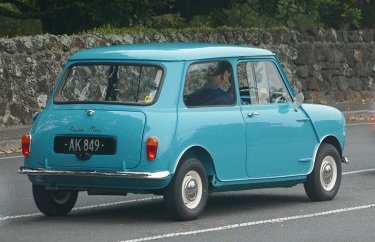
AUSTIN MINI 850
Noel Mountjoy is only the second owner of this Mk1 Mini which took him five and a half years to fully restore.
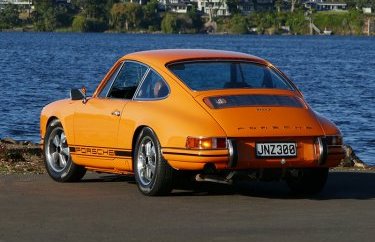
PORSCHE 911T
Dave’s narrow-bodied 911T gives him an authentic 911 experience and the power to embarrass modern sportscars.
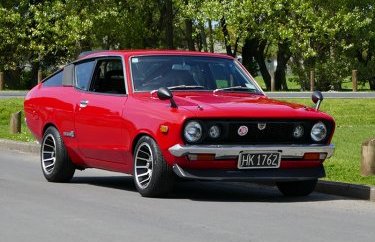
DATSUN 120Y COUPE
After a happy honeymoon, Datsun owner Brett is still taken with his 120Y. But he wants a second carb under the hood.
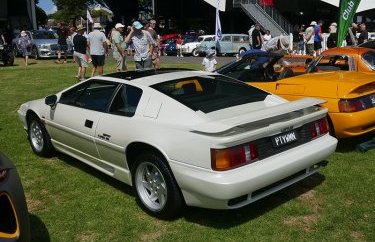
CLASSICS & CONCOURS
More than 60 car clubs showcased members’ cars for the public to admire at picturesque racecourse.
